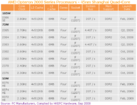- Joined
- Oct 9, 2007
- Messages
- 47,343 (7.51/day)
- Location
- Hyderabad, India
| System Name | RBMK-1000 |
|---|---|
| Processor | AMD Ryzen 7 5700G |
| Motherboard | ASUS ROG Strix B450-E Gaming |
| Cooling | DeepCool Gammax L240 V2 |
| Memory | 2x 8GB G.Skill Sniper X |
| Video Card(s) | Palit GeForce RTX 2080 SUPER GameRock |
| Storage | Western Digital Black NVMe 512GB |
| Display(s) | BenQ 1440p 60 Hz 27-inch |
| Case | Corsair Carbide 100R |
| Audio Device(s) | ASUS SupremeFX S1220A |
| Power Supply | Cooler Master MWE Gold 650W |
| Mouse | ASUS ROG Strix Impact |
| Keyboard | Gamdias Hermes E2 |
| Software | Windows 11 Pro |
AMD would be releasing 45nm silicon fabricated series of the quad-core Opteron processor based on the newer Shanghai core. Like its desktop PC counterpart, the Deneb core, it features 6 MB of L3 cache along with some enterprise-specific features. They will be designed for high-uptime and energy efficiency. AMD banks heavily on the performance efficiency and virtualization capabilities of these processors. There are primarily two types of these processors based on the multi-processor capabilities: the 2000 series 2-way processors and the 8000 series 8-way processors. The former supports two-socket systems while the latter is designed for dense 2+ socket environments, where up to 8 Opteron processors could work in tandem. The processors continue to have Socket-F (s1207) interfaces, hence the entire lineup retains its DDR2 memory standard.
Interestingly, AMD did not rework the system interface for all its newer chips. Across the vast lineup of 20 models, only four support the newer HyperTransport 3.0 interface with 4400 MT/s interconnects. The rest continue to use the 2000 MT/s interconnects. It could be mid-2009 by the time AMD launches its own enterprise-segment chipsets, which could also be the time when the current leading player, NVIDIA launches its newer nForce Professional lineup for the Opteron. Since current chipsets from both NVIDIA and Broadcom feature only the older HyperTransport 2000 MT/s interfaces, it could explain why most of these chips feature it.


View at TechPowerUp Main Site
Interestingly, AMD did not rework the system interface for all its newer chips. Across the vast lineup of 20 models, only four support the newer HyperTransport 3.0 interface with 4400 MT/s interconnects. The rest continue to use the 2000 MT/s interconnects. It could be mid-2009 by the time AMD launches its own enterprise-segment chipsets, which could also be the time when the current leading player, NVIDIA launches its newer nForce Professional lineup for the Opteron. Since current chipsets from both NVIDIA and Broadcom feature only the older HyperTransport 2000 MT/s interfaces, it could explain why most of these chips feature it.


View at TechPowerUp Main Site
Last edited:





